The Best Semi-Automatic Espresso Machines, According to Our Tests
Dotdash Meredith and Yahoo Inc. may earn commission or revenue on some items through the links below.
We have top picks at every price point, including models from Breville and Gaggia.

Serious Eats / Jesse Raub
The Breville Bambino Plus is our favorite overall espresso machine for its performance, compact size, and price. For beginners, we loved the built-in grinder and assisted tamping from the Breville Barista Express Impress. However, home espresso aficionados might prefer the customizable Gaggia Classic Pro or the Breville Dual Boiler, while experts will love the souped-up power of the Rancilio Silvia Pro X, La Marzocco Linea Micra, and La Marzocco Linea Mini.
At its core, an espresso machine pressurizes hot water through finely-ground coffee to pull a concentrated espresso shot—but even the term “pull” is a little old-fashioned. Originally, “pull” was used to describe baristas literally pulling on a spring-loaded lever that drove a piston through a column of hot water into the coffee. Nowadays, most espresso machines you see in cafes and in homes are semi-automatic.
In simple terms, a semi-automatic espresso machine has an electronic button or switch that the barista (or home barista) uses to start and stop the espresso shot. It’s a relatively user-friendly, cost-effective design that’s easier to operate than manual machines and usually more affordable than automatic and superautomatic machines (which can cost between $3,000 and $7,500 for home models). To help you wade through this wide category of equipment, we put together a list of our favorite semi-automatic options.
The Winners, at a Glance
The Best Small Semi-Automatic Espresso Machine: Breville Bambino Plus
The Best Semi-Automatic Espresso Machine for Tinkerers: Gaggia Classic Pro
The Best Semi-Automatic Espresso Machine with a Built-In Grinder: Breville Barista Express Impress
An Entry-Level Dual Boiler Semi-Automatic Espresso Machine: Breville Dual Boiler
A Sturdier Dual Boiler Semi-Automatic Espresso Machine: Rancilio Silvia Pro X
A Splurge-Worthy Semi-Automatic Home Espresso Machine: La Marzocco Linea Micra
A Truly Professional Semi-Automatic Espresso Machine: La Marzocco Linea Mini
Things to Consider
So, What Is the Difference Between Semi-Automatic and Automatic Espresso Machines?
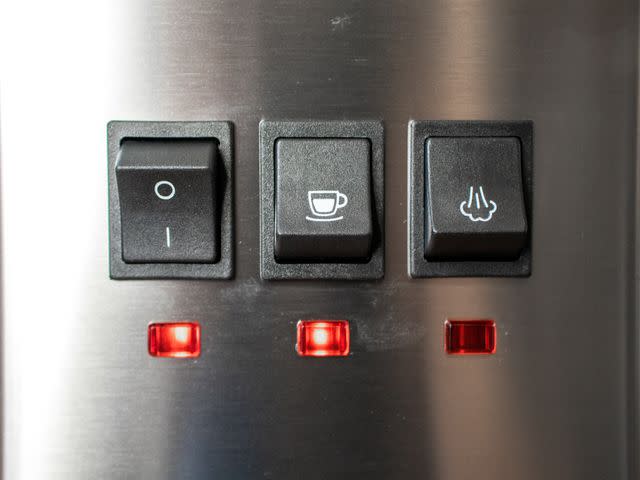
Serious Eats / Ashley Rodriguez
The control panel on the Gaggia Classic Pro has just three buttons: on/off, steam mode, and in the center, a switch that starts and stops the flow of water.To put it plainly, automatic machines are able to stop espresso shots automatically. You’re most likely to see one at a busy high-end coffee bar where automation helps move the line forward, but there are automatic home machines, too. The guts of both types of machines are extremely similar, with one key difference: automatic espresso machines have a flow meter. Most flow meters use a tiny magnet in the water line and track the number of times it spins as an espresso shot is running. It then uses this data to pump the same amount of water through the machine every time, and can even be programmed to the exact millimeter. While automatic machines are great, accurate flow meters are an extremely sensitive, expensive precision device, and even most commercial espresso machines don’t have them.
Semi-automatic espresso machines rely on a more basic way to stop each espresso shot: the user. While they require a bit more attention, semi-automatic machines are more affordable, have fewer complex parts, and are extremely reliable, making them a great option for a home espresso machine.
Hang on—Aren’t Those Breville Espresso Machines Automatic?

Serious Eats / Ashley Rodriguez
While most Breville machines come with two programmable volume buttons, they weren't accurate enough for us to use them as automatic espresso machines.Technically, yes: but as we mentioned in the previous paragraph, accurate flow meters are extremely sensitive and expensive. In our testing, we found the flow meters in Breville machines were lacking in precision. Espresso recipes are extremely specific because just five milliliters of water can throw off the entire flavor of a shot, and the only machine we’ve used that’s that accurate is the La Marzocco GS/3 (which is $7,500). We still really, really like these Breville machines, but we had better success when we stopped the shots ourselves.
In the Intro You Mentioned Superautomatic Machines. What’s Up With Those?
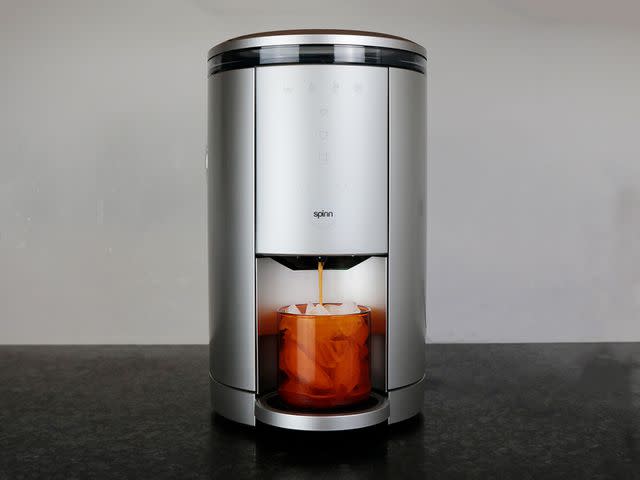
Serious Eats / Jesse Raub
We recommend the Spinn over traditional superautomatic espresso machines, as it was more versatile, less expensive, and generally makes better tasting coffee.Ah, yes: the superautomatic espresso machine. If you’ve ordered a drink at a large coffee chain, your drink was made on a commercial, superautomatic machine, though there are home versions, too. Superautomatic machines do everything: push a button, and they grind, dose, tamp, and brew. Many offer automatic milk frothing, too. Because there are so many moving parts, they’re expensive (around $2,000 for most entry level home models), not to mention a nightmare to maintain. Lastly, without human input on how much water or coffee is being used or how coarse or fine the grind is set, the espresso from these machines is rarely better than passable. They represent ultimate convenience, but we think the Spinn Coffee Maker, which is a one-touch brewer that uses a centrifugal brewing chamber, does a better job (and for half the price, too).
I Keep Hearing About Dual Boiler Vs. Single Boiler Machines—Does It Really Matter?

Serious Eats / Ashley Rodriguez
The Rancilio Siliva Pro X has dual boilers so you can pull a shot and steam milk at the same time.It may sound like technical jargon, but yes—the number of boilers an espresso machine has matters a ton. Single boiler machines rely on one water boiler to heat water for brewing (around 200ºF) and for steaming milk (around 266ºF). Since these two functions happen at entirely different temperatures, you have to take turns between pulling a shot and steaming milk. Some machines (like the Breville Bambino Plus and the Barista Impress Express) can switch functions pretty quickly, but the Gaggia Classic Pro takes 45 seconds to heat up and steam milk—long enough for the espresso shot you just pulled to begin to oxidize and turn sour. Dual boiler machines offer three main advantages: simultaneous espresso pulling and milk steaming, precision temperature control, and steam power. With separate boilers for brewing and steam, you can do both at the same time. Plus, separate steam boilers are usually bigger and offer more power (which helps create better textured microfoam for smooth latte art, if you want to show off). There are two major downsides to dual boiler machines, though: they’re bigger, and cost much more.
What Does PID Stand for and Why Does It Make Better Coffee?
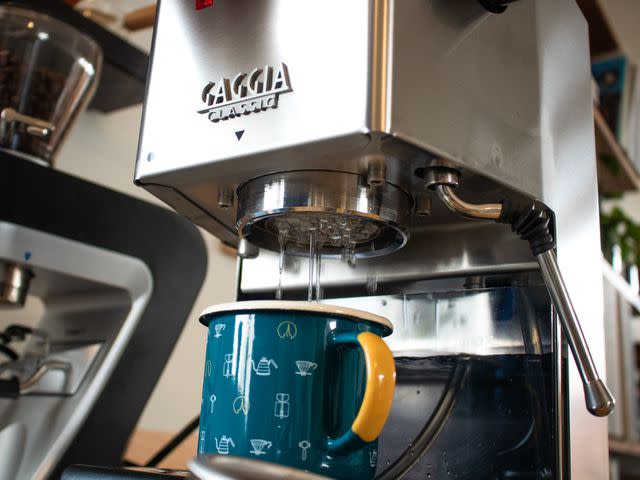
Serious Eats / Ashley Rodriguez
Without PID-driven precision temperature control, the Gaggia Classic Pro requires you to purge water to regulate water temperature.Lots of machines advertise that they have a PID controller, but there’s not a lot of information out there about what that actually is and what it does. PID stands for “proportional integral derivative,” which is an algorithm that can be used to predict temperature swings and then adjust the boiler to correct them. It’s a common piece of technology in immersion circulators and high-end toaster ovens to stabilize temperatures but was originally popularized in espresso machines through home enthusiasts who liked to modify their equipment. Without a PID, the brew boiler might swing 20ºF as the heating cycle kicks on; with a PID, the temperature can be stabilized within 0.1ºF. High temperatures can bring out bitter flavors, while low-temperature shots might taste sour. Having a PID in your machine eliminates guesswork and leads to more consistent, better-tasting espresso.
Are Expensive Espresso Machines Really Worth It?

Serious Eats / Jesse Raub
It's easier to pull great shots on a pricier machine, like the Linea Micra, but all of our picks can make tasty espresso.This is a loaded question, but it’s also very personal. All of our picks are able to make great tasting espresso and aerate microfoam into milk, it’s just that the expensive machines do it better. How much better? Well, that’s tough to say. The most expensive machines on this list are a lot easier to work on, but beginners might not know enough about espresso minutiae to warrant the upgrade. At the same time, an expert will find it easier to pull a great tasting shot on a $500 machine than a beginner, but might long for the precision of a pricier piece of equipment. This guide hopefully can help you balance the features you’re looking for against your budget, and all of these machines are great options for home use.
Okay, But What About Grinders?
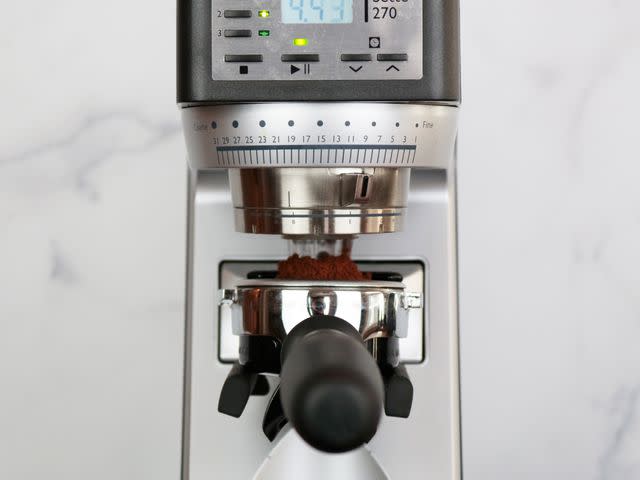
Serious Eats / Jesse Raub
The precision grind adjustment of the Baratza Sette 270 makes it our favorite espresso grinder.You’re right—an espresso machine isn’t anything without a great espresso grinder. In our testing, the Baratza Encore ESP came out as a really solid option to pair with a lower-cost machine for a budget-friendly duo. It can manage precision espresso grinds while also tackling coarser grinds for drip brewing, making it an excellent choice for those who want a grinder that can do double duty. The Baratza Sette 270 was our favorite grinder, hands down, but is a little pricey for beginners. It has a continuous micro-adjustment lever for fine-tuning your espresso shots, and its unique burr design holds onto less coffee and makes it super easy to clean. For the high-end machines, the Mazzer Lux D packs the power of a commercial espresso grinder into a body that fits on most counters.
The Criteria: What to Look for in a Semi-Automatic Espresso Machine

Serious Eats / Jesse Raub
While there are a number of different machines with an array of features and varying price points, a great semi-automatic espresso machine should be easy to use and be able to pull a cafe-quality shot of espresso. It should also have a powerful enough steam wand to create microfoam and be able to switch between brewing and steaming modes easily (if it doesn’t have dual boilers). Ideally, it has precision temperature regulation via a PID controller (though it’s not necessary). Ultimately, a great semi-automatic espresso machine lets you make the drinks you want at a price point that matches your budget.
The Best Small Semi-Automatic Espresso Machine: Breville Bambino Plus Espresso Machine

What we liked: Not only were we impressed with this machine's espresso, but we also really loved the automatic steam wand, which shuts off when it hits the right temperature, ensuring silky, well-aerated foam every time. We were also surprised by how quickly the machine heats up—it took just seconds for the machine to reach brewing temperature, which is regulated by a PID. It’s a great all-around machine for beginners and enthusiasts on a budget, and is countertop friendly.
What we didn’t like: The quality of the microfoam from the automatic steam wand wasn’t quite as good as a skilled home barista could produce with a manual steam wand. This machine also has programmable buttons for single or double shots (technically making it an automatic espresso machine), but they weren’t very accurate.
Price at time of publish: $500.
Key Specs
Dimensions: 8 x13 x 12 inches
Weight: 11 pounds
Portafilter diameter: 54 millimeters
Capacity: 1 liter
Boiler: Single
PID: Yes
Warranty: 2-year limited product warranty
Comes with: 54mm tamper, precision dosing tool, 16 fl.oz / 480ml stainless steel milk jug, 1- and 2- cup single wall and dual wall filter baskets, cleaning tool, cleaning disc
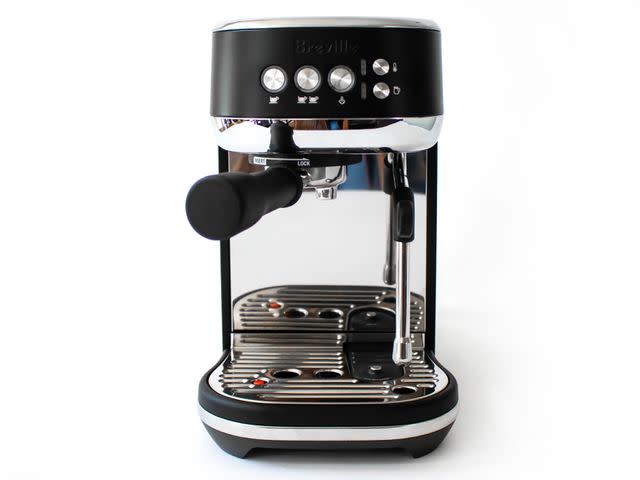
Serious Eats / Ashley Rodriguez
The Best Semi-Automatic Espresso Machine for Tinkerers: Gaggia Classic Pro Espresso Machine

What we liked: The Gaggia Classic Pro pulled incredible tasting shots that matched the quality of machines three times its price, and its commercial-sized grouphead meant we could swap the filter baskets for high-end versions. There’s also tons of information online about how to modify your shot-pulling experience in order to bring out incredible coffee quality, like how to temperature surf the brew boiler or amp up the steam pressure. It’s a great option for anyone willing to invest a little extra time and who considers pulling espresso a hobby.
What we didn’t like: This machine lacks a PID controller to regulate its temperature, requiring the user to monitor the brew boiler to keep it from scorching the coffee. It also takes a while to heat up for making steam, and even then the pressure isn’t very strong. This machine is better suited for an espresso-focused person who occasionally enjoys a latte.
Price at time of publish: $400.
Key Specs
Dimensions: 9 x15 x 9.5 inches
Weight: 16 pounds
Portafilter diameter: 58 millimeters
Capacity: 2 liters
Boiler: Single
PID: No
Warranty: 1-year limited warranty
Comes with: Single and double single- and dual- wall filter baskets, plastic tamper

Serious Eats / Ashley Rodriguez
The Best Semi-Automatic Espresso Machine with a Built-In Grinder: Breville the Barista Express Impress

What we liked: Assisted tamping and automatic coffee portioning automate the two trickiest parts of pulling a shot, making this machine a great option for beginners or those who just don’t enjoy tinkering. It heats up quickly and can jump to steam mode in just seconds, producing enough pressure for good-quality microfoam. To get more in depth about how the built-in grinder works with the tamping lever, you can read our dedicated review here.
What we didn’t like: The built-in grinder is handy, but lacks the precision and power that some of our favorite espresso grinders have. And even though it has a built-in grinder, it’s still more expensive than some standalone grinders and espresso machine pairings that we would recommend.
Price at time of publish: $800.
Key Specs
Dimensions: 13 x 15 x 16 inches
Weight: 24 pounds
Portafilter diameter: 54 millimeters
Capacity: 2 liters
Boiler: Single
PID: Yes
Warranty: 2-year repair or replacement limited warranty
Comes with: 480ml stainless steel milk jug, 1- and 2- cup single and dual wall filter baskets, Water filter holder with filter, precision trimming tool, cleaning tablets, allen key, steam wand cleaning tool, cleaning disc, cleaning brush, descale powder
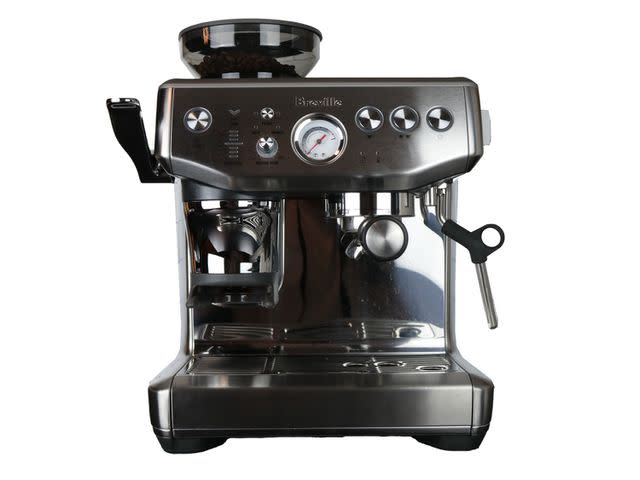
Serious Eats / Jesse Raub
An Entry-Level Dual Boiler Semi-Automatic Espresso Machine: Breville BES920XL Dual Boiler Espresso Machine

What we liked: Though we haven’t officially tested the Breville Dual Boiler, our staff has a lot of experience with this machine and highly recommend it. It’s the cheapest dual boiler machine out there, and even though it’s a big price jump compared to most of Breville’s machines, it’s packed with features. Dual boilers allow the user to pull shots and steam milk at the same time, and you can even tweak your brew temperature. With a commercial-sized filter basket and a grouphead that keeps temperatures steady, the Dual Boiler offers more precision than any of its siblings, and it also has a built-in shot-timer. It’s an excellent choice for anyone who wants to step up their espresso game, but who still wants the user-experience details of a Breville machine (like wheels to help it move around the counter, a pop-up sign when the drip tray is full, and cleaning instructions right on the water reservoir).
What we didn’t like: At this price point, we wish it wasn’t mostly made out of plastic. We also wish the steam pressure was more powerful, so it could create a silkier microfoam.
Price at time of publish: $1,600.
Key Specs
Dimensions: 15.9 x 14.7 x 14.9 inches
Weight: 30 pounds
Portafilter diameter: 58 millimeters
Capacity: 2.5 liters
Boiler: Dual
PID: Yes
Warranty: 2-year repair warranty
Comes with: 58mm razor dosing tool, 58mm stainless steel portafilter. 1-cup & 2-cup single and dual wall filter baskets, integrated tamper, 16-ounce stainless steel milk jug, cleaning kit, water hardness test strip, water filter holder and water filter

Serious Eats / Jesse Raub
A Sturdier Dual Boiler Semi-Automatic Espresso Machine: Rancilio Silvia Pro X Espresso Machine

What we liked: The Silvia Pro X crams a lot of commercial features—and parts—into a home machine. Aside from the machine’s sturdy stainless steel body, it also offers precision temperature control and lets the user fine tune the exact flavor profile they want out of their espresso. We also really liked the power behind the steam wand, which made it easy to make excellent microfoam. This is a great option for anyone with a larger budget who wants a machine that’s built to last.
What we didn’t like: It’s an expensive machine and only offers minor improvements over the less pricey options on this list. Still, it is excellent.
Price at time of publish: $1,940.
Key Specs
Dimensions: 16.5 x 10 x 15.2 inches
Weight: 44 pounds
Portafilter diameter: 58 millimeters
Capacity: 2 liters
Boiler: Dual
PID: Yes
Warranty: 1-year parts and labor warranty
Comes with: Black handle double spouted commercial portafilter, 7-gram single basket, 18-gram double basket, rubber backflush insert, stainless steel tamper, water softening pouch, coffee scoop

Serious Eats / Jesse Raub
An Ultra Splurge Semi-Automatic Home Espresso Machine: La Marzoccousa Linea Micra

What we liked: La Marzocco is known for its precision commercial espresso machines, and they were able to make a home version that feels like working on the real thing. The Linea Micra is an incredible feat of engineering. Not only can it pull shots and steam milk simultaneously, it also has precision temperature control and a commercial-style pump, all packed into a kitchen-countertop-friendly body. Oh, and you can use the app that pairs with it to schedule on/off times. It was a dream to pull shots with the Linea Micra, and you can read more about how much we liked it in our review.
What we didn’t like: The only real issue with this machine is the price: it’s twice the cost of other dual boiler machines on this list, and while the build quality is worth it, it also puts the Linea Micra in a category that only the most dedicated enthusiasts would be willing to shell out for.
Price at time of publish: $3,900.
Key Specs
Dimensions: 12 x 12 by 15 inches
Weight: 40 pounds
Portafilter diameter: 58 millimeters
Capacity: 2 liters
Boiler: Dual
PID: Yes
Warranty: 2-year parts and labor warranty
Comes with: Convertible portafilter with dual-spout and single-spout attachment, 7-gram, 14-gram, 17-gram, and 21-gram baskets, 58mm convex La Marzocco tamper, 12oz steaming pitcher, Purocaf Cleaning Solution
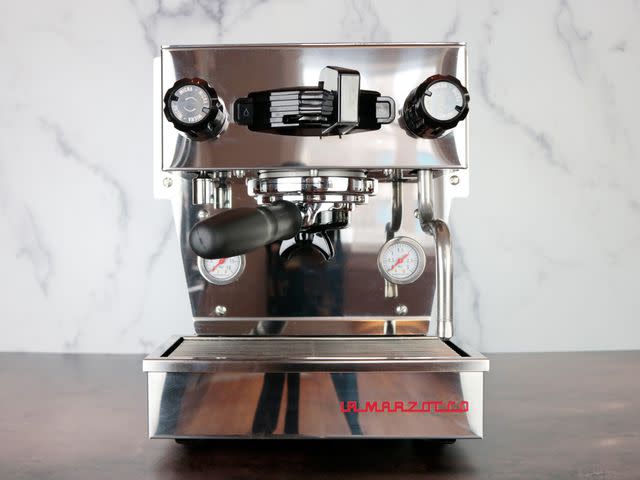
Serious Eats / Jesse Raub
A Truly Professional Semi-Automatic Espresso Machine: La Marzocco Linea Mini Espresso Machine

What we liked: The Linea Mini has all the same features of the Linea Micra, just in a bigger body with larger boilers. It’s often used for pop-up coffee events when someone needs a portable machine with a lot of power, and it delivers. And while other machines in this list have good steam pressure, the Linea Mini’s steam wand goes toe-to-toe with any commercial machine twice its size. It may be overkill for most people’s needs, but for anyone who wants cafe-quality espresso at home, the Mini is one of the best options available.
What we didn’t like: In contrast with its name, the Linea Mini is big—it weighs around 80 pounds when full. It’s also extremely expensive, dwarfing any other espresso machine’s cost on this list.
Price at time of publish: $5,900.
Key Specs
Dimensions: 14 x 21 x 16 inches
Weight: 70 pounds
Portafilter diameter: 58 millimeters
Capacity: 2 liter
Boiler: Dual
PID: Yes
Warranty: 2-year parts and labor warranty
Comes with: Break-away double spouted portafilter with standard rubber handle, 7-gram, 14-gram, 17-gram, and 21-gram baskets, 58mm convex La Marzocco tamper, 12-ounce steaming pitcher, Purocaf Cleaning Solution

Serious Eats / Jesse Raub
FAQs
What is a semi-automatic espresso machine?
A semi-automatic espresso machine uses a single button to start and stop an espresso shot. There are no preset volumes on a semi-automatic espresso machine the way there are on an automatic/volumetric machine, requiring the user to stop shots.
How much should you pay for a good espresso machine?
We have recommendations for espresso machines at a variety of price points. The lowest-priced espresso machine we recommend is the Gaggia Classic Pro, which is around $400, while the most expensive machine, the La Marzocco Lina Mini, is $5,900. There are a lot of great models in between these two machines with various jumps in price, but in general, pricier espresso machines make it easier to pull a delicious espresso shot and have more powerful steam pressure.
How do I clean my espresso machine?
Most espresso machines are cleaned through backflushing, which involves putting a filter basket with no holes into the portafilter, adding coffee detergent, and running the grouphead. This flushes water and coffee detergent up through the grouphead to clear out any old coffee oils—but before you attempt this, check with the manufacturer’s instructions. Some machines don’t have the right type of valve that lets you backflush, and this could damage the machine.
Read More:We Tested 14 Espresso Machines to Find the Best Ones, Depending on Your Needs

